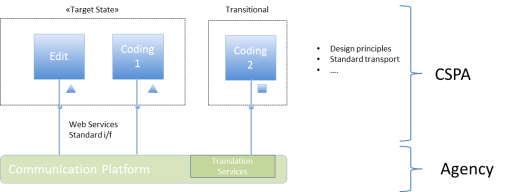169. The CSPA provides the following definition of Technology Architecture:
"Technology Architecture (TA) describes the IT infrastructure required to support the deployment of business services, data services and applications services, including hardware, middleware, networks, platforms, etc."
170. Within each statistical organization, there needs to be an infrastructural environment in which the generic services can be combined and configured to run as element of organization specific processes. This environment is not part of CSPA. CSPA assumes that each statistical organization has such an environment and makes statements about the characteristics and capabilities that such a platform must have in order to be able to accept and run Statistical Services that comply with CSPA.
171. Platform for Service Communication: A communication platform provides the capability for communication between Statistical Services. It enables inter-service communication while allowing Statistical Services to remain autonomous and adds additional capabilities for monitoring and orchestrating the information flow. To assemble a built Statistical Service, the communication platform is updated to integrate with new services. There are multiple ways of establishing a communication platform. Examples of architectural components could be; BPMS, ESB, Workflow Engines, Orchestration Engines, Message Queuing and Routing.
172. Platform for Configuring and Controlling Services and Processes: The Platform for Controlling Service and Process execution encompasses the functionalities and tools to support the management and maintenance of services metadata, artefacts and policies. Examples of how this mechanism could be achieved include Business Process Modelling System, Lifecycle Management, Service Monitoring and Management.
173. Platform for Reporting on Services and Processes: The Platform for reporting is responsible for enabling real-time monitoring and near-real-time presentation of user defined business key performance indicators (KPIs). Examples of how this mechanism could be achieved are; Static Dashboard or Business Activity Monitoring (also generates alerts and notifications to user when these KPIs cross specified thresholds).
174. CSPA provides guidance on the way that organizations should go about building new or wrapping existing Statistical Services. When the time comes for an organization to use a Statistical Service that conforms to CSPA there are some organization specific technology approaches that also need consideration.
175. CSPA does not specify how organizations will coordinate the use of Statistical Services to implement a wider business process. Organizations will need a technology solution to support communication between Statistical Services since the Statistical Services are not to talk directly to each other.
176. Where the Statistical Service being used is largely independent, interfaces between that Statistical Service and others may be manually managed by a person. There may also be other relatively trivial uses of Statistical Service where a bespoke solution to integrate them is developed. These are sub-optimal yet pragmatic ways of achieving reuse of Statistical Services.
177. Where the integration of Statistical Services is non-trivial, a communications platform of some sort will usually be required. The key functions of the communication platform are:
178. Figure 10 illustrates the relationship between the elements that are specified in CSPA and the underlying Communications Platform that is local to an Organization.

Figure 10: Statistical Service Components and Communication Platforms
179. In this diagram, two Statistical Services (Edit, Coding 1) have been defined and specified in compliance with CSPA, and their implementations are communicating with each other within the environment of a statistical organization. The Statistical Service instances communicate with each other through the organization's communication platform – this may be a full SOA implementation (bus or broker), a CORE implementation, or some other more rudimentary platform (or no platform at all).
180. It is important to state that CSPA does not prescribe the capabilities and architecture of the underlying Communications Platform – it instead assumes that an organization's Assemblers and Configurers will be responsible for addressing how the platform supports the use of CSPA-compliant Statistical Services. This allows CSPA and its Statistical Services to be used by the widest possible community amongst statistical organizations, all of who may be in different stages of development and modernization.
181. In the diagram one can see that there is a second Coding Statistical Service (Coding 2) that doesn't (yet) implement the complete CSPA Statistical Service Specification due to a transitional state. An organization may optionally make use of some form of translation service to address differences between their interfaces (typically at the information encoding level). This is seen as a transitional state – the goal is to ensure that all services adhere to the Statistical Service Specification, while allowing for differences at the Statistical Service implementation level at the protocol level (and underlying platforms).